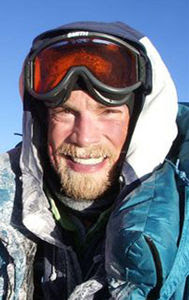aluminum crampons, lightweight pants and a lightweight longsleeve top. I carried a BD Bullet pack with 2 liters of Cytomax in a hydration bladder, a light Goretex top, warm hat, and gloves. For fuel I carried 6 Gu packages and a pack of Shot Blocks. Overall, the route conditions and weather were almost perfect. The route was direct above the Cleaver and there wasn't much for traffic aside from the guided parties, who were all quite nice in letting me pass. I went to the tippy top and took the time to sign in at the register. It was quite windy on the crater rim and on the summit; aside from that the breeze was pleasant and I did not have to add any layers except a pair of gloves during the ascent. The descent went well--good snow for plunge-stepping and striding out pretty much all the way down. I did fall once on moderate terrain near 13000' as I was cutting some switchbacks--slid a couple meters before regaining my feet. On the descent, I left my pack at Muir and my crampons at Pebble Creek--thanks to the guides for carrying them down. I timed myself on my Suunto watch, and also used the logbook funtion to record the ascent/descent. The only "proof" I have of the times are a couple of before and after photos of the watch, and video taken with the same camera, before and after (I left the camera in a stuffsack at the trailhead). I did sign the register, and saw a lone climber on Columbia Crest, but did not speak with him.
This was my 106th summit of Rainier, by my best count.
~Justin Merle
 In mid-September, one of our lead climbing rangers, David Gottlieb, took off for Kathmandu on a climbing trip through the Himalayas. David's climbing partner, Joe Puryear, is a previous Mt. Rainier climbing ranger and friend. Their goal was a first ascent of Kang Nachugo (6,735 meters), found within the Himalayan Valley of Rolwaling. Joe set up a climbing blog, so that friends, fellow climbers, and family can stay up-to-
In mid-September, one of our lead climbing rangers, David Gottlieb, took off for Kathmandu on a climbing trip through the Himalayas. David's climbing partner, Joe Puryear, is a previous Mt. Rainier climbing ranger and friend. Their goal was a first ascent of Kang Nachugo (6,735 meters), found within the Himalayan Valley of Rolwaling. Joe set up a climbing blog, so that friends, fellow climbers, and family can stay up-to- date on their progress. We all waited patiently for news of their climb and verification of their safety. Thankfully, a post on October 25th stated simply that they were successful and were safe. Their blog now has a full trip report, complemented by some amazing pictures - definitely worth a full read-through. We just want to say "Congratulations" to both Joe and David, while wishing them safe travels home. We hope to see you on the Mountain soon!
date on their progress. We all waited patiently for news of their climb and verification of their safety. Thankfully, a post on October 25th stated simply that they were successful and were safe. Their blog now has a full trip report, complemented by some amazing pictures - definitely worth a full read-through. We just want to say "Congratulations" to both Joe and David, while wishing them safe travels home. We hope to see you on the Mountain soon!













